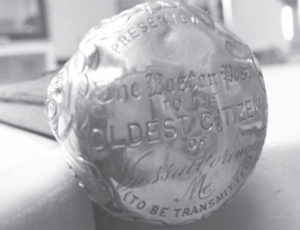by Landis Hudson
Using trucks to move thousands of fish into a lake isn’t exactly the way nature intended it, but sometimes that’s what it takes. In the spring of 2014 Maine’s Department of Marine Resources stocked 21,000 adult alewives into China Lake as an important first step in the Alewife Restoration Initiative. Another important step in the works is to dismantle the Masse saw mill in East Vassalboro. The mill’s owner, East Vassalboro Water Co., LLC, supports the project. Donald Robbins (co-owner) has given presentations to members of the community at the Vassalboro Grange and the Vassalboro Historical Society. Plans to remove the dilapidated saw mill and leaking Masse Dam will benefit the water company customers. The project calls for water pipes to be relocated, they are currently at risk of damage and contamination if the dam breaches or if the mill collapses into the stream. 
While this part of the project will benefit customers of the East Vassalboro Water Company, the overall goal is to reconnect Outlet Stream’s historic alewife habitat. Alewives are native to Outlet Stream and China Lake but haven’t been seen there for generations, not since mills and dams were built hundreds of years ago.
A migratory species, adult alewives (also known as river herring or by their Latin name, Alosa pseudoharengus) migrate every spring from the ocean to lakes and ponds to reproduce before migrating back to the ocean. They are a ten-inch long silvery fish, known as the “fish that feed all” because of the great number of creatures eat them – from whales, eagles and osprey to turtles, brook trout, otter and mink.
In assessing the options at the Masse site, project partners determined that a dam removal was the best option but two other dams on the Outlet Stream will remain. The China Lake Outlet Dam will remain because it regulates the water level of China Lake. The Ladd Dam will also remain and a technical fishway will be installed to keep the swimming hole, protect sanitary sewer pipes and so that alewife harvesting can take place there. The site of the Masse Dam would be very challenging and expensive for installation of a technical or rockramp fishway because of the naturally occurring curve of the stream, the nearby road and the gradient of the slope fish would need to swim up in order to make their way up in the stream.
Removing the Masse Dam will not dry up the Outlet Stream. The level of the water in China Lake is regulated by the Maine Department of Environmental Protection (DEP) and controlled by the Outlet Dam that is owned by the Town of Vassalboro. The minimum flow rate for Outlet Stream, also set by DEP, is 10 cubic feet per second (10 cfs).
 Dismantling the Masse saw mill is a considerable undertaking. The history of the site is being fully documented according to precise specifications of the Maine Historic Preservation Office. Efforts are being made to find homes for as much of the historic equipment as possible. Volunteers and staff from the Maine Forest and Logging Museum, in Bradley, will be visiting the site soon. As Sherry Davis, director of the Museum writes, “It will be nice if there is potential for us to help save some part of the Masse heritage.”
Dismantling the Masse saw mill is a considerable undertaking. The history of the site is being fully documented according to precise specifications of the Maine Historic Preservation Office. Efforts are being made to find homes for as much of the historic equipment as possible. Volunteers and staff from the Maine Forest and Logging Museum, in Bradley, will be visiting the site soon. As Sherry Davis, director of the Museum writes, “It will be nice if there is potential for us to help save some part of the Masse heritage.”
While the saw mill and dam will be dismantled, the historic “grist mill” building will remain on the site, with the Outlet Stream flowing by. “We’ve got a lot of work to do this summer and in the coming seasons to complete the project, but I look forward standing on the stream banks with my kids, watching alewives swim by the Masse grist mill,” says Jennifer Irving, executive director of Sebasticook Regional Land Trust, a project partner. As Richard Behr, Vassalboro resident and Registered Maine Guide says, “These are complicated projects to take on but the successes are so important.”
The Alewife Restoration Initiative is a collaborative undertaking with state, federal and nonprofit organizations working together, with the towns of Vassalboro and China offering their support.





 Dismantling the Masse saw mill is a considerable undertaking. The history of the site is being fully documented according to precise specifications of the Maine Historic Preservation Office. Efforts are being made to find homes for as much of the historic equipment as possible. Volunteers and staff from the Maine Forest and Logging Museum, in Bradley, will be visiting the site soon. As Sherry Davis, director of the Museum writes, “It will be nice if there is potential for us to help save some part of the Masse heritage.”
Dismantling the Masse saw mill is a considerable undertaking. The history of the site is being fully documented according to precise specifications of the Maine Historic Preservation Office. Efforts are being made to find homes for as much of the historic equipment as possible. Volunteers and staff from the Maine Forest and Logging Museum, in Bradley, will be visiting the site soon. As Sherry Davis, director of the Museum writes, “It will be nice if there is potential for us to help save some part of the Masse heritage.”